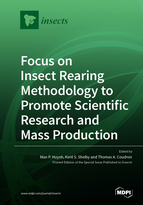Focus on Insect Rearing Methodology to Promote Scientific Research and Mass Production
A special issue of Insects (ISSN 2075-4450). This special issue belongs to the section "Insect Physiology, Reproduction and Development".
Deadline for manuscript submissions: closed (30 June 2021) | Viewed by 36890
Special Issue Editors
Interests: insect nutrition; metabolomics; toxicology; insect artificial diet development; corn rootworm resistance management
Special Issues, Collections and Topics in MDPI journals
Interests: insect nutrition; biochemistry; physiology; genomics of biological control agents
Special Issue Information
Dear Colleagues,
The ability to produce insects has a broad impact on human lives in a wide array of areas including insect pest and weed management, human and veterinary medicine, insect production for food and nutrient supplements, as well as research and education. Artificial diets allow for the mass production of insects in simpler, highly controlled, cost-effective, and more convenient ways compared to natural foods. Ideal artificial diets can ultimately serve as suitable substitutes for natural foods and support the production of insects physically and behaviorally similar to those from nature. Often, the use of artificial diets results in more uniform and consistent production of high-quality insects for research and field applications. New multi-omics technologies (transcriptomics, nutrigenomics, metabolomics, etc.), increased knowledge of microbiomes, and the manipulation of nutrigenomic analysis and statistical optimization modeling have enabled advances in diet formulation. These advances have resulted in a better understanding of the effects of the food stream ingredients on the insect’s physiological and biochemical functions, in addition to promoting the production of high-quality insects.
For this Special Issue, we are seeking original submissions and reviews in the field of insect rearing on artificial diets: development, commercialization, and novel research applications.
Dr. Man P. Huynh
Dr. Kent S. Shelby
Dr. Thomas A. Coudron
Guest Editors
Manuscript Submission Information
Manuscripts should be submitted online at www.mdpi.com by registering and logging in to this website. Once you are registered, click here to go to the submission form. Manuscripts can be submitted until the deadline. All submissions that pass pre-check are peer-reviewed. Accepted papers will be published continuously in the journal (as soon as accepted) and will be listed together on the special issue website. Research articles, review articles as well as short communications are invited. For planned papers, a title and short abstract (about 100 words) can be sent to the Editorial Office for announcement on this website.
Submitted manuscripts should not have been published previously, nor be under consideration for publication elsewhere (except conference proceedings papers). All manuscripts are thoroughly refereed through a single-blind peer-review process. A guide for authors and other relevant information for submission of manuscripts is available on the Instructions for Authors page. Insects is an international peer-reviewed open access monthly journal published by MDPI.
Please visit the Instructions for Authors page before submitting a manuscript. The Article Processing Charge (APC) for publication in this open access journal is 2600 CHF (Swiss Francs). Submitted papers should be well formatted and use good English. Authors may use MDPI's English editing service prior to publication or during author revisions.
Keywords
- insect rearing methodology
- artificial diet
- mass production








